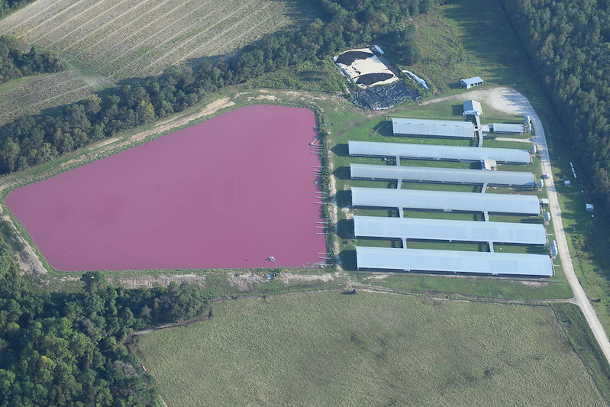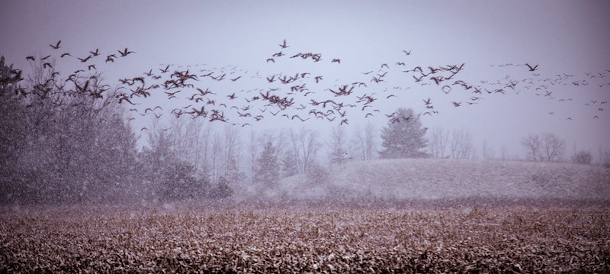Beyond the Headlines
Air Date: Week of October 29, 2021
Scientists estimate that the North Atlantic right whale population reached a 20-year low of 336 in 2020. (Photo: New England Aquarium)
This week, Environmental Health News Editor Peter Dykstra shares a sobering update about declining northern right whale numbers with Host Steve Curwood. Also, an increase in industrial poultry farms is adding to North Carolina’s massive hog waste problem. And in the history calendar, the anniversary of a Midwest blizzard that spurred a mass migration of waterfowl heading south all at once and shut down airports.
Transcript
CURWOOD: Time now to speak to Peter Dykstra. Peter's an editor with the Environmental Health News. That's ehn dot org, and dailyclimate dot org. And he's on the line now from Atlanta, Georgia, where he's been looking over what's going on beyond the headlines for us. Hi there, Peter, and what do you have for us today?
DYKSTRA: Hi, Steve, a little follow up on a little bad news. We heard on last week's show that Northern right whales are getting smaller. But they've also had a couple of really, really bad years for reproduction. And the population count is as small as it's been in at least 20 years, with last year, the count being 336 Northern right whales remaining.
CURWOOD: Boy, they had gotten up to more than 400 at one point over these last 20 years. I guess those entanglements with fishing gear and collisions with ships are, are taking their toll, huh?
DYKSTRA: They are, and other possible reasons that the population is going down, despite a huge effort to make it recover are things like climate change, because once those animals are through with mating season down here off the Georgia and Florida coasts, they head north for feeding season. And climate change has affected where their food sources are. That may be a reason that the population is hurting, for an animal that got its name because it was, for whalers centuries ago, the "right whale" to kill. It was very slow, its habitat was near the coast, and when you harpooned it, and it died, it didn't sink, it floated near the surface.
CURWOOD: Yeah, well, these numbers are very disturbing, but I gather that the folks who follow the Northern right whales still feel that they have some hope. What is the source of their hope, do you think?
DYKSTRA: Well, there's so much attention on the few animals that are left that ship strikes and entanglements can be more of a focus, and the right whale to kill may be the right whale to save.

A hog CAFO (concentrated animal feeding operation) in North Carolina photographed from the air. (Photo: Matt Butler, Sound Rivers, Waterkeeper Alliance Inc., Flickr, CC BY-NC-ND 2.0)
CURWOOD: Let's hope so. Hey, what else do you have for us this week?
DYKSTRA: We're gonna talk about Carolina CAFOs, Concentrated Animal Feeding Operations. The right whales are getting smaller here in the northern hemisphere, but the hogs are actually getting larger. In North Carolina, a state already beset by water and air pollution from some of the biggest hog farms in the country, if not the world, those hog farms are getting bigger. And not only that, but they're now outnumbered by poultry farms: chickens and turkeys with many of the same pollution problems, including the smell. If you were to go down I-95 in eastern North Carolina, there are places where you just have to roll up the windows rather than endure the smell.
CURWOOD: And let me guess, in terms of environmental justice, these Concentrated Animal Feeding Operations with all the manure and such are in -- communities of color?
DYKSTRA: Pretty much so, far more so than in white communities. Eastern Carolina is a heavy farming district, it always has been. They once had a lot of tobacco farms. They've been phased out, because these hog operations are much, much bigger, in addition to the fact that tobacco is at least a little bit phased out in this country.
CURWOOD: Well, also though, meat is being questioned as a contributor to climate disruption. So I guess time will tell. Hey, Peter, what do you have for our look back into history this week? Tell me what you see.

Waterfowl taking flight amid a snowstorm (Photo: Christian Collins, Flickr, CC BY-SA 2.0)
DYKSTRA: November 1, 1995, there was an early blizzard on the Canadian prairie that sparked a "Grand Passage." That's the name that's given to when all of the waterfowl, ducks and geese pack up and fly south at the same time. There were millions, an estimated 50 to 80 million ducks and geese abruptly heading south across the central US, the Mississippi River flyway. So many ducks and geese that at one point, airport radar became virtually useless. And the airports in Kansas City and Omaha had to close down because of ducks and geese.
CURWOOD: They were worried about quack-ccidents, I suppose?
DYKSTRA: Well, that would be a little daffy. But I have to say that waterfowl have prospered in the Midwest, largely due to the efforts of farmers and duck hunters and conservationists like Ducks Unlimited protecting the small ponds and the wetlands along the flyway, allowing ducks and geese to prosper to the point where they actually shut down airports.
CURWOOD: That's good news at a time when we seem to be losing so many species. Thank you so much, sir! Peter Dykstra is an editor with Environmental Health News, that's ehn dot org and dailyclimate dot org. And we will talk to you again real soon!
DYKSTRA: All right, Steve, thanks a lot, talk to you soon.
CURWOOD: And there's more on these stories on the Living on Earth webpage, that's loe dot org. And, honk if you like it.
Links
About the decline in the North Atlantic right whale population
The New York Times archive | “With Habitat Restored, Ducks in the Millions Create Fall Spectacle”
Living on Earth wants to hear from you!
Living on Earth
62 Calef Highway, Suite 212
Lee, NH 03861
Telephone: 617-287-4121
E-mail: comments@loe.org
Newsletter [Click here]
Donate to Living on Earth!
Living on Earth is an independent media program and relies entirely on contributions from listeners and institutions supporting public service. Please donate now to preserve an independent environmental voice.
NewsletterLiving on Earth offers a weekly delivery of the show's rundown to your mailbox. Sign up for our newsletter today!
 Sailors For The Sea: Be the change you want to sea.
Sailors For The Sea: Be the change you want to sea.
 The Grantham Foundation for the Protection of the Environment: Committed to protecting and improving the health of the global environment.
The Grantham Foundation for the Protection of the Environment: Committed to protecting and improving the health of the global environment.
 Contribute to Living on Earth and receive, as our gift to you, an archival print of one of Mark Seth Lender's extraordinary wildlife photographs. Follow the link to see Mark's current collection of photographs.
Contribute to Living on Earth and receive, as our gift to you, an archival print of one of Mark Seth Lender's extraordinary wildlife photographs. Follow the link to see Mark's current collection of photographs.
 Buy a signed copy of Mark Seth Lender's book Smeagull the Seagull & support Living on Earth
Buy a signed copy of Mark Seth Lender's book Smeagull the Seagull & support Living on Earth

